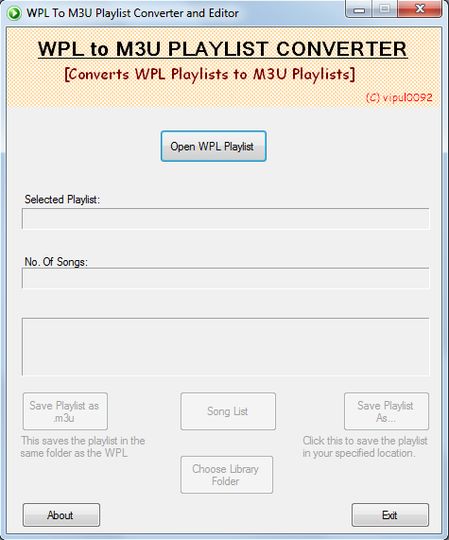

For example, an MP3 file created using the setting of 128 kbit/s will result in a file about 1/11 the size of the CD file created from the original audio source. Lossy compression is designed to reduce significantly the amount of data required to represent the audio recording and still sound like a faithful reproduction of the original uncompressed audio. It is a common audio format for consumer audio streaming or storage and a de facto standard of digital audio compression for the transfer and playback of music on most digital audio players. MPEG-1 or MPEG-2 Audio Layer III, more commonly referred to as MP3, is an audio coding format for digital audio that uses lossy data compression. WPL files do not contain any audio or video data at all. However, the WPL file contains only songs or other media files and their paths.

#Wpl to m3u converter series#
It is the default playlist format in Windows Media Player 9 Series and later. wpl file format can contain dynamic playlists. Just single out those playlists that didn’t convert and leave them in the wpl folder, then rename them to have no symbols in them, and convert!īob DuCharme's weblog, mostly on technology for representing and linking information.The.
#Wpl to m3u converter code#
Don’t reconvert all your playlists again, this code isn’t that smart. If they do, write down their names and then rename them and put them back into the wpl folder. Some playlists fail to convert due to their names. It will take a while to convert it automatically and to rename them correctly but you wont have to do anything but double click and wait. wpl playlist files into the wpl folder, and hit Convert! PRESTO! You now have all your wpl playlists converted to m3u. wpl playlist files into the wpl folder, and hit Convert PRESTO You now have all your wpl playlists converted to m3u. Now edit convert.bat and put in this following code:įor %%a in (wpl/*.wpl) do java -jar saxon9he.jar “wpl/%%a” “style.xsl” >“m3u/%%~na.m3u” Now edit convert.bat and put in this following code: for a in (wpl/.wpl) do java -jar saxon9he.jar wpl/a style.xsl >m3u/na.m3u. Now create a text file in the default (wpltom3u) directory and rename it to style.xsl, then edit it with notepad and paste in the XSLT code posted above.Ĭreate another file and rename it to convert.bat. jar of Saxon XSLT into the default (wpltom3u) folder. Now create a folder called wpltom3u (or of your choosing) and go into that folder.Ĭreate two additional folders, one titled wpl and another titled m3u. Here are some instructions to use this sucker: (If you like classic Bollywood soundtracks, check out Music from the Third Floor if you’re new to it and interested, start with the compilations there.) 1 Comments With a long plane ride tomorrow night to go to Oxford for the XML Summer School, I want to load up the MP3 player with something conducive to sleeping, so I just converted my playlist of Lata Mangeshkar ballads so that I can put that on. The is a trick I’ve used more lately to get XSLT to output a carriage return, because if I put an actual carriage return inside of an xsl:text element like I always did before, telling Emacs to re-indent the whole thing tends to screw that up. It’s not very long, but if you want fancy XSLT, I have a recursive named template, which I wrote for something else but modified here to look for the text after the last backslash. I did some web searches for wpl2m3u and only found one script that I couldn’t quite follow, and after taking a closer look at the WPL format I realized that an XSLT stylesheet to convert it to M3U would be very simple.

To convert WPL files to m3u for Songbird, reading them individually into Windows Media Player and exporting them one at a time was annoying. Windows Media Player can create WPL files, which seem to conform to the W3C SMIL standard, and it can export M3U files, which MediaMonkey uses. Guess which of these uses the most standardized, XML-based format for playlists? Surprise: the Microsoft one. It looks a bit like iTunes, without all the ads in your face how great is that?īefore that I used MediaMonkey, and before that, the Windows Media Player. I suppose I should call them “media players”, but I only use them to play music, which is part of the reason I ended up using Songbird, an open source Windows/Linux/Mac music front end that doesn’t pretend to be anything else. I’ve switched around between music-playing programs over the last few years. After taking a closer look at the WPL format I realized that an XSLT stylesheet to convert it to M3U would be very simple.


 0 kommentar(er)
0 kommentar(er)
